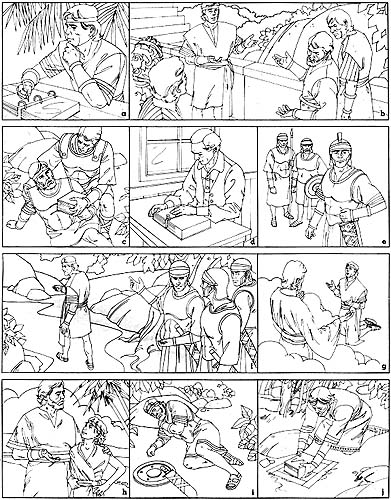“Sharing Time: Mormon—a Valiant Prophet,” Friend, Jan. 1988, 36
Sharing Time:
Mormon—
a Valiant Prophet
When ye are in the service of your fellow beings ye are only in the service of your God (Mosiah 2:17).
Imagine that you are asked to keep a written record of the people of your country and to also write a shortened record of over one thousand years of their history. While you are doing this, your people are at war, and you must often hide to protect your writings. You may not use a typewriter or computer but must inscribe on metal plates so that your record can be safely buried in the earth.
Mormon kept a history of his people, and he also abridged, or shortened, the writings on the plates of Nephi. Because of this, his writings are called “The Book of Mormon.” You may never be asked to do what Mormon did, but no matter what hard things you face, you can be a valiant servant like Mormon.
Instructions
Read statements about Mormon, then number pictures to match story. (Color the pictures.)

Illustrated by Paul Mann
1
A righteous man named Ammaron wrote about his people, then hid the record so that wicked people would not find it. (See 4 Ne. 1:47–49.)
2
When Mormon was ten years old, Ammaron told him where the records were and instructed Mormon to retrieve the plates of Nephi when he, Mormon, was twenty-four years old. (See Morm. 1:2–4.)
3
Mormon was a serious boy and obeyed God’s commandments. When he was fifteen, he was visited by the Savior. (See Morm. 1:15.)
4
Even though Mormon was only sixteen, he was a natural leader and was chosen to lead the Nephite armies, which he did for many years. (See Morm. 2:1–2.)
5
Eventually the Lamanites won more and more battles and forced the Nephites to the north. Mormon took the plates of Nephi from the hill Shim and began his own record on them. (See Morm. 2:3, 17.)
6
The Nephites were near destruction, but Mormon encouraged them to stand firm, and for ten years there were no wars. Mormon preached the gospel, but his people would not repent. (See Morm. 2:23–24; Morm. 3:1–3.)
7
When new battles began, the Nephites were victorious. They vowed to destroy all the Lamanites. Because of the Nephites’ wickedness, Mormon refused to lead them. (See Morm. 3:7–11.)
8
Later Mormon agreed to lead the Nephites into battle though he knew they would soon be destroyed. At the Hill Cumorah, he was wounded, and thousands were killed. (See Morm. 5:1; Morm. 6:1–10.)
9
Mormon hid most of the sacred records in the Hill Cumorah; he gave the gold plates to his son Moroni and charged him to finish the record. (See Morm. 6:6; Morm. 8:1.)
10
Years later Moroni hid the gold plates in the Hill Cumorah. In 1823 he showed them to Joseph Smith. Four years later Joseph began translating Mormon’s record.
Sharing Time Ideas
-
Enlarge pictures, and have children hold them out of sequence. Tell story, and have children arrange pictures in the correct order.
-
Provide copy of page for each child. Discuss with them Mormon’s service as they cut out pictures and glue them in correct order on colored paper.
-
Using dictionary, define valiant. Make chart with headings WHO and WHAT. Put Mormon’s name under WHO chart and have children tell what he did that was valiant. Add other Book of Mormon characters throughout year. Add names of valiant people whom the children know.
-
Sing related songs, such as “Called to Serve” (Hymns, no. 249) and “I Can Be Valiant” (Supplement to More Songs for Children, page 9).
-
Explain abridge by reading complete story to children and having them retell important parts in shorter version.